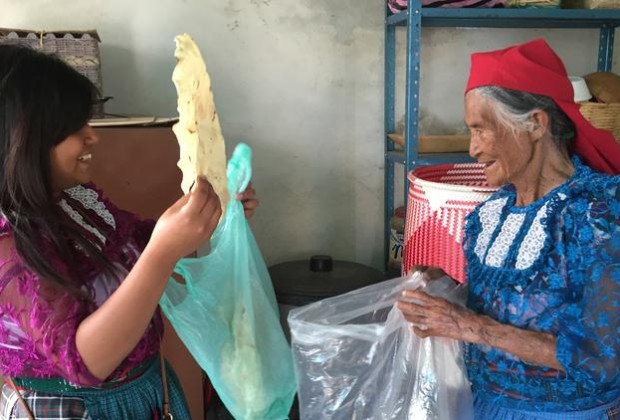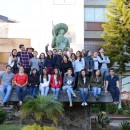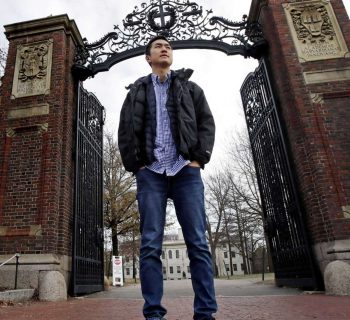By Cindy Carcamo, Los Angeles Times ~ January 22, 2016
After her mother whisked her away at age 8 from her pueblo in Oaxaca to the Mid-City neighborhood of Los Angeles, Veronica Martinez Sanchez forgot most of what her life was like at the foot of Picacho Mountain.
The few memories that remained were of the loquat tree she climbed as a child and the splashes of yellow and red flowers emblazoned on the traditional blouse of her grandmother Sofia Gomez — a woman Martinez remembered as tall, slim and strong.
Those fuzzy images and the stories her mother and father recounted made her yearn for her place of birth.
For most of her life, though, these were only wistful yearnings — without legal status, she could never hope to safely reenter the U.S. Then came President Obama’s Deferred Action for Childhood Arrivals program, which in addition to protecting many children brought into the country illegally from deportation, opened the door for some of them to leave the country temporarily.
The problem: There are no guarantees that U.S. immigration agents at the border will honor those who have applied for these so-called “advance paroles.”
If she went “home” to Oaxaca, she might never be able to return “home” to Los Angeles.
Martinez decided to try.
She became one of a growing number of young “dreamers” across the U.S. who are traveling back to Mexico and Central America, learning to traverse two worlds — and discovering they are citizens of both.
“I didn’t realize I was so Americanized. I didn’t want to accept it,” Martinez, 27, said after spending several months with her grandmother last year, conversing comfortably in their native Zapotec. “You become used to life in the U.S. That’s the truth.”
Martinez, who often wears a brilliant white smile framed by high cheekbones, was silent and nervous on the plane south. During a shared taxi ride from the airport to her village, her heart pounded when she caught view of rocky Picacho Mountain and of Zapotec women with brilliant green, red and yellow traditional dresses walking along the road.
Martinez, who was worried about her command of the Zapotec language, surprised herself and the women in her taxi when she joined the conversation. They complimented her on how well she spoke despite being away for so long. Finally, Martinez thought, she was “back home.”
San Bartolome Quialana, a rural village in the southern state of Oaxaca, has a population of about 2,000 people, most of them Zapotec women and children. About half of the town — mostly young men — has migrated north to California.
Her parents were part of that migration. Though Martinez spent most of her life in the U.S., she said it never really felt like home.
But when she got to her village, wearing a T-shirt and shorts — her daily garb in California — she didn’t quite fit in either.
Women looked at her from head to toe and said her shorts revealed too much skin. They were reserved and short when she tried to make conversation. It wasn’t until a few weeks in, when she decided to don the traditional Zapotec dress, that she felt like part of the community.
“You look so pretty now,” women told her.
At first I felt like I was neither from here nor over there. Now, I feel like both are home- Veronica Martinez Sanchez
Generally, U.S. Citizenship and Immigration Services will grant advance parole for DACA recipients only if they have a qualifying humanitarian, employment or educational reason to travel abroad. Some "dreamers" were brought to the U.S. illegally, some overstayed visas and now live in the country without documentation.
San Bartolome Quialana, a rural village in the southern state of Oaxaca, has a population of about 2,000 people, most of them Zapotec women and children. About half of the town — mostly young men — has migrated north to California.
Her parents were part of that migration. Though Martinez spent most of her life in the U.S., she said it never really felt like home.
But when she got to her village, wearing a T-shirt and shorts — her daily garb in California — she didn’t quite fit in either.
Women looked at her from head to toe and said her shorts revealed too much skin. They were reserved and short when she tried to make conversation. It wasn’t until a few weeks in, when she decided to don the traditional Zapotec dress, that she felt like part of the community.
“You look so pretty now,” women told her.
At first I felt like I was neither from here nor over there. Now, I feel like both are home- Veronica Martinez Sanchez
Generally, U.S. Citizenship and Immigration Services will grant advance parole for DACA recipients only if they have a qualifying humanitarian, employment or educational reason to travel abroad. Some "dreamers" were brought to the U.S. illegally, some overstayed visas and now live in the country without documentation.

Hilaria Sanchez Hernandez and Eleuterio Hernandez Hernandez in their store in San Bartolome Quialana. (Cindy Carcamo / Los Angeles Times)
A visit to Mexico comes with “a lot of responsibility, more than one may have imagined,” Esquivel said.
Martinez normally spent the mornings with Gomez, making her coffee and eating eggs. Weekly, she’d accompany her to the Sunday fair in the nearby town of Tlacolula, where the pair talked over barbacoa de borrego — roasted lamb in adobo marinade — and hot chocolate.
One morning in her grandmother’s kitchen, Martinez, who wore a traditional long skirt and blouse with purple flowers, flashed Gomez a smile.
“I do this for my dad because I know he can’t be here for my grandma,” she said. “I just wanted to make my grandma happy — at least for a couple of months.”
Martinez’s father sends money every month to his mother, hoping it will help her pay for expenses — perhaps a trip to a doctor who can attend to her eyes.
Instead, the grandmother socks it away, hoping he’ll return one day so she can give it to him.
“Aren’t you happy I’m here?” Martinez asked her grandmother.
The grandmother squinted her eyes.
“Yeah. Yeah. But you’re leaving again,” she replied. “I don’t know why you want to go. When you go, I’ll stay alone.”
Gomez has asked why Martinez couldn’t attend a school in the village. Martinez didn’t even try to explain. She’ll graduate from UC Riverside this year and plans to study indigenous communities in graduate school.
When Gomez was asked whether she’d ever had the desire to visit the U.S. to see her family, the grandmother responds with an adamant “no.”
“I’d probably die if I go over there. I don’t want to go. I have my animals to tend to and I can’t take my animals,” she said.
Martinez reached out and stroked her grandmother’s face with affection.
“I’m not the greatest nieta — granddaughter,” she said in English. “I wish I could spend more time with her, but it’s hard to be here and see her in this way. Lonely … by herself.”
Martinez left her village in December, nervous about whether she’d be allowed back into the U.S. The lines at customs at Los Angeles International Airport confused her a bit. Should she queue up at the one for U.S. citizens or the one for foreigners? She chose the latter.
An agent sent her for a secondary inspection. After a few hours came the verdict: She could return.
She was happy to be back but was soon itching to return to her Oaxacan village. She knows it may be quite a while before she’ll be able to do so legally.
For now she straddles both homes as best she can, often wearing her flowery blusa — blouse — with her shorts.

After 15 years of separation, Veronica Martinez Sanchez, left, and Sofia Gomez had the opportunity to reconnect in their Oaxacan village of San Bartolome Quialana. (Cindy Carcamo / Los Angeles Times).
'Dreamer' se reencuentra con su familia en un pueblo de Oaxaca
'Dreamer' se reencuentra con su familia en un pueblo de Oaxaca…
Por Cindy Carcamo, Los Angeles Times ~ Enero 22, 2016
Luego de que su madre se la llevó de su pueblo en Oaxaca a un vecindario de Los Ángeles cuando tenía 8 años, Verónica Martínez Sánchez olvidó casi todo lo que era su vida a los pies de la montaña Picacho.
Uno de los pocos recuerdos que le quedaban era el del árbol que solía trepar cuando era niña y los brillantes colores de las flores amarillo y rojo que adornaban la tradicional blusa de su abuela Sofía Gómez, a quien Martínez recordaba como una mujer alta, delgada y fuerte.
Las borrosas imágenes e historias que su madre y padre le cuentan la hacen anhelar su lugar de nacimiento.
Sin embargo, la mayor parte de su vida aquellos, habían sido solo melancólicos recuerdos, porque sin la documentación necesaria, ella no podía regresar a Estados Unidos—. Pero entonces vino la Acción Diferida (DACA) del presidente Obama, que además de proteger de la deportación a los menores que entraron al país sin papeles, le abrió las puertas a algunos de ellos para salir del país temporalmente.
El problema: no hay garantía de que los agentes de inmigración dejarán reingresar a quienes han aplicado para dicho beneficio.
Si iba a su “casa” en Oaxaca, podría nunca poder regresar a su “casa” en Los Ángeles.
De todas formas, Martínez decidió intentarlo.
Ella se convirtió en parte del creciente número de 'soñadores' en Estados Unidos que están viajando de regreso a México y Centroamérica, aprendiendo a viajar entre esos dos mundos, y descubriéndose como ciudadanos de ambos.
“No sabía que estaba tan americanizada. No quería aceptarlo”, dice Martínez, de 27 años, luego de pasar varios meses con su abuela el año pasado, paseándose por su nativo pueblo zapoteco. “Te acostumbras a la vida en Estados Unidos. Ésa es la verdad”.
Martínez iba callada y nerviosa en el avión hacia su primer hogar. Cuando iba en el taxi del aeropuerto a su pueblo, su corazón se aceleró al ver la montaña Picacho y a las mujeres zapotecas que caminaban a la orilla del camino vistiendo los tradicionales vestidos multicolores que ella recordaba.
Martínez, quien estaba preocupada de si recordaría cómo hablar el dialecto zapoteca, se sorprendió a sí misma cuando se unió a la conversación de las mujeres que compartieron el taxi con ella. La felicitaron por lo bien que hablaba a pesar de que había estado lejos por tanto tiempo. Finalmente, Martínez se dio cuenta que estaba “de regreso en casa”.
San Bartolome Quialana, un pueblo rural en el sureño estado de Oaxaca, tiene una población de cerca de 2,000 personas, la mayoría de ellos mujeres y niños zapotecas. Casi la mitad del poblado —la mayoría hombres jóvenes— han emigrado hacia el norte, a California.
Sus padres fueron parte de esa migración. Aunque Martínez ha pasado la mayor parte de su vida en EE.UU., dice que nunca se ha sentido como en su casa.
Pero cuando llegó a su pueblo, vistiendo pantaloncillos y camiseta —como lo hace todos los días en California — no encajó muy bien.
Las mujeres la recorrían de pies a cabeza y le decían que estaba muy destapada. Eran más reservadas y cortantes cuando Verónica quería platicar con ellas. No fue sino hasta unas semanas después, luego que decidió ponerse el tradicional vestido zapoteca, que se sintió parte de la comunidad.
“Ahora sí te ves muy bonita”, le decían las mujeres.
Generalmente los Servicios de Inmigración y Aduanas estadounideneses permiten la salida y reingreso de los beneficiarios de DACA solo por razones humanitarias, de trabajo o escolares. Algunos 'soñadores' fueron traídos a Estados Unidos ilegalmente, y otros se quedaron más del tiempo que les permitían sus visas.
Según las autoridades migratorias, en los primeros dos años que DACA ha estado vigente, alrededor de 6,400 beneficiarios han solicitado salir del país. No se sabe a cuántos se les ha negado el reingreso.
Martínez recibió el permiso por razones escolares, gracias a un programa de investigación auspiciado por UC Riverside, donde está estudiando sociología y antropología. Ella tomó clases en la Ciudad de México, pero pasó la mayor parte del tiempo en un proyecto de investigación independiente, enfundada en un vestido tradicional en su pueblo.
Aunque pronto se adaptó al lento estilo de vida del lugar, también tuvo una revelación inesperada.
Se vio a sí misma refiriéndose a Estados Unidos como su "casa". También lo extrañba.
“Primero me sentía como que no era de aquí ni de allá”, dijo respecto a México y EE.UU. “Ahora siento que los dos son mi hogar. Tengo el derecho de estar aquí y allá. El hogar es donde está la familia. Tengo familia aquí y allá”.
El sentimiento es similar para muchos otros en la misma situación, dice Angélica Esquivel, una reciente egresada de UCLA que hizo una investigación sobre jóvenes que regresan a México con este beneficio.
Esquivel, de 24 años y quien también pudo ir a México amparada en el mismo beneficio —para su investigación y visitar a su familia—, dice que muchos de quienes participaron en su estudio, entre ellos Martínez, descubrieron durante su estancia en México lo arraigados que realmente están en Estados Unidos.
“Han aceptado su papel de actores transnacionales”, dice Esquivel. “Cuando estás en EE.UU., te acuerdas y extrañas México. Y estando en México extrañas tu vida en Estados Unidos. Siempre extrañarás el uno o el otro”.
Martínez también experimentó lo que cualquiera siente cuando vuelve a su lugar de origen en la infancia —el recuerdo y la realidad no concuerdan—. El árbol que trepaba cuando niña ya no parecía tan alto, ni su abuela tan fuerte.
Gómez, ahora de 85 años, luce frágil y vive en una pequeña casa de ladrillos de ceniza. Su visión es borrosa debido a las cataratas que la aquejan, y a veces se pierde en el pueblo.
Martínez también pasa tiempo con sus abuelos maternos, Rosa y José Sánchez, que también viven en el pueblo, pero le pone especial atención a Gómez. El español es la segunda lengua de la abuela, así que ambas platican principalmente zapoteca.
En muchos sentidos, ella asumió el rol de sus padres, que no pueden ir a México porque, al igual que mucha gente sin papeles, no tienen beneficios migratorios.
Rosa Sánchez le dijo a su nieta algo que a ambas las hizo ‘quebrarse’.
“El que estés aquí es como si mi hija estuviera aquí”, le dijo. “Es como si tu mamá hubiera venido a visitarme”.
Otros que participaron en el estudio de Esquivel también se encontraron con un sentido de mayor responsabilidad, entendiendo que de alguna forma terminaron “representando” a sus padres.
Una visita a México implica “una gran responsabilidad, mayor de la que uno se hubiera imaginado”, asegura Esquivel.
Martínez normalmente pasa las mañanas con su abuela, haciendo café y comiendo huevos. Cada semana la acompaña al cercano pueblo de Tlacolula, donde ambas platican mientras comen barbacoa de borrego y chocolate caliente.
Una mañana en la cocina de su abuela, Martínez —vistiendo un tradicional vestido largo y blusa de flores moradas— le tira a Gómez una sonrisa.
“Hago esto por mi papá, porque sé que no puede estar aquí con mi abuela”, dice. “Solo quería que ella estuviera feliz, al menos por un par de meses”.
El padre de Martínez le manda dinero cada mes a su madre, con la esperanza de que le alcanzará para sus gastos —quizás hasta para ir a ver al doctor a que le revise los ojos—.
En vez de eso, la anciana guarda el dinero, con la esperanza de que su hijo algún día regresará y se lo podrá regresar.
“¿No estás feliz de que esté aquí?”, le pregunta Martínez a su abuela.
“Sí, sí. Pero te vas a ir de nuevo”, le contesta. “No sé por qué te quieres ir. Cuando te vayas me voy a quedar sola”.
Gómez le ha preguntado a su nieta por qué no puede ir a una escuela en el pueblo. La joven ni siquiera trata de explicárselo. Ella se graduará de UC Riverside este año y planea hacer un postgrado en comunidades indígenas.
Cuando se le preguntó a Gómez si alguna vez había tenido el deseo de visitar a su familia en Estados Unidos, la anciana contestó con un contundente “no”.
“Probablemente me moriría si voy allá. No quiero ir. Tengo mis animales que cuidar y no me los puedo llevar”, dice.
Martínez se acercó a su abuela y le acarició el rostro en señal de ternura.
“No soy la mejor nieta”, dice. “Me gustaría poder pasar más tiempo con ella, pero es difícil estar aquí y verla de esta forma, sola”.
Martínez se fue de su pueblo en diciembre, con el miedo de si la dejarían regresar a Estados Unidos. Las filas de inmigración en el aeropuerto de Los Ángeles la confundieron un poco. ¿Debería formarse en la de ciudadanos estadounidenses o la de extranjeros? Escogió la segunda.
Después de varias horas para una inspección minuciosa de su caso, la dejaron regresar.
Verónica estaba feliz de estar de vuelta, pero pronto le dio la ‘cosquilla’ de regresar a su pueblo en Oaxaca, aunque sabe que tal vez pase un buen tiempo antes de que pueda hacerlo con la documentación adecuada.
Por ahora trata de combinar lo mejor que puede las raíces de sus dos hogares, vistiendo su blusa floreada y sus pantaloncillos.
Si desea leer esta nota en inglés, haga clic aquí







